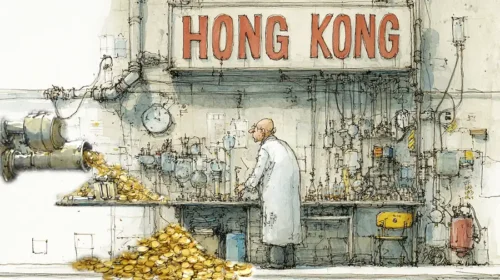Stimulus moves give China and Hong Kong stocks a lift

China has launched a rescue mission for slumping Hong Kong and mainland share markets after the Hang Seng index fell below 15,000 points
Key Takeaways:
- Beijing is rolling out a host of measures to boost economic growth and support sagging stock markets. The policies helped Hong Kong’s Hang Seng jump 4.2% last week, breaking a January losing streak
- Under a new policy, market valuation will become a performance metric for officials at state-owned enterprises, creating an incentive for price-boosting share buybacks
By A. Au
Finally, a glimmer of light after Chinese and Hong Kong stocks made a dismal start to the year.
The gloom had been unremitting since 2024 trading began. The Shanghai Composite Index fell below 2,900 points on Jan. 8 and broke below 2,800 points at the start of last week. Hong Kong’s Hang Seng also got off to a pitiful start as nervy foreign investors continued to flee the market. Even the CEO of Hong Kong Exchanges and Clearing Ltd. (0388.HK), Nicolas Aguzin, conceded that confidence was lacking, leaving the market close to the point of a “capitulation” sell-off. The Hang Seng was plumbing the depths below 15,000 points, sinking as far as 14,794 last week, only about 200 points off a 15-month low.
But then last Tuesday the clouds parted slightly. Financial news provider Bloomberg reported on Jan. 23, quoting unnamed sources, that Beijing was mulling a series of market support measures including a 2 trillion yuan ($282 billion) stabilization fund. Drawing on money held offshore by Chinese enterprises, the fund would invest in mainland Chinese shares as well as the Shanghai-Hong Kong and Shenzhen-Hong Kong Stock Connect schemes. In addition, the central bank would stand ready to support the yuan, while state-owned financial bodies China Securities Finance or Central Huijin Investment would pump at least 300 billion yuan into the A-share market.
After the report landed, the Hang Seng rallied by as much as 550 points and closed back above the key 15,000 level, with a gain for the day of 392 points or 2.6 percent. The next day, the People’s Bank of China sprang another surprise, announcing a 50-point cut in reserve ratio requirements for banks, double what the market had expected. The release of 1 trillion yuan in liquidity sent strong signals about Beijing’s resolve to bolster economic growth and stimulate the stock markets. Chinese and Hong Kong shares rallied again, propelling the Hang Seng another 545 points higher, a 3.6 percent jump from the previous close.
Policy stimulus did not stop there. The central bank also made it cheaper for the agricultural sector and small firms to borrow money, cutting the re-lending and re-discount rates by 0.25 percentage point. Caps on credit lines extended to small and micro businesses were raised from 10 million yuan per loan to 20 million yuan.
The package also offered some relief for the ailing property sector, with measures to relax the rules on bank loans for commercial real estate, boosting the liquidity available to indebted developers. It was enough to send many property stocks soaring.
Investors were particularly excited about a new incentive for officials at state-owned enterprises to maximize the market value of their businesses. The new measure makes market capitalization a performance metric for executives, who are encouraged to shore up investor confidence through share purchases or buy-backs. Executives wanting to climb the career ladder at state-owned businesses will have to pay closer attention to the stock price.
Companies have been swift to express their commitment. China Telecom (0728.HK; 601728.SH) was the first to come out with a statement about its efforts to manage market cap. CNOOC (0883.HK; 600938.SH) CEO Zhou Xinhuai told a conference call that a dedicated team was looking at ways to support market value in line with the authorities’ instructions.
US-China concerns
Last week’s market rally was mostly driven by China-focused stocks, including many heavyweights in the energy sector. CNOOC rose four days in a row, gaining 11.3% in Hong Kong and 11.8% in mainland trading. CNPC (0857.HK; 601857.SH) surged 16.5% in Hong Kong and 20.6% in Shanghai trading. Even laggard Sinopec (0386.HK; 600028.SH) jumped 10% in both A-share and H-share markets in the same period.
Other stocks such as China Mobile (0941.HK; 600941.SH), China Telecom and China Unicom (0762.HK) rose by 5%, 7% and 11% respectively. The coal stock China Shenhua Energy (1088.HK; 601088.SH) leapt 11.3%, while China Aluminum International (2068.HK; 601068.SH) surged more than 40% in a single day. Even banking stocks eked out a gain of 3% to 4%. The broad-based rally stands in stark contrast to the market’s recent spiral of doom.
All told, Beijing’s policy interventions powered a 4.2% weekly gain for the Hang Seng, reversing a three-week losing streak as funds started to flow back into the battered market.
In the week ending Jan. 24, China-focused stock funds logged a net inflow of $11.9 billion, the highest weekly gain since July 2015, according to EPFR data cited by Bank of America. One of the biggest ETFs tracking Chinese stocks, iShares China Large-Cap ETF (FXI.US), chalked up its biggest weekly turnover of call options in more than a year. All signs that investors may be cheering up about Chinese stocks.
Dickie Wong, executive director of research at Kingston Securities, said the central bank has taken vigorous steps and may go even further by cutting other lending rates in the coming weeks. “With this host of measures from Beijing, sentiment is improving in mainland and Hong Kong markets. The Hang Seng Index might have reached the bottom and be ready to turn,” he said.
Still, Beijing’s rescue efforts cannot dispel every market worry. China’s sputtering economic recovery and fears of escalating friction with the US have also fed into the deep, three-year slump. It emerged on Jan. 26 that Hang Seng component companies Lenovo (0992.HK) and WuXi Biologics (2269.HK) are at risk of being sanctioned by the US. Lenovo’s computers could be barred from use within the U.S. government and WuXi Biologics is among the Chinese biotech companies listed in a proposed congressional bill that would restrict access to federal contracts. The biotech’s stock plunged 20%, weighing on the Hang Seng.
Despite the policy stimulus, investors are still jumpy and will rush for the exits in the face of uncertainty, said Kingston Securities’ Wong, noting that reassurances from WuXi Biologics could not stem the stock sell-off. “In this environment of China-US competition, the market is jittery about any sign of possible US sanctions,” he said, advising investors to steer clear of stocks that could end up in the crosshairs in a US election year. China-focused stocks with less US exposure would be a safer and cheaper choice right now, he said.
The Bamboo Works offers a wide-ranging mix of coverage on U.S.- and Hong Kong-listed Chinese companies, including some sponsored content. For additional queries, including questions on individual articles, please contact us by clicking here.
To subscribe to Bamboo Works free weekly newsletter, click here






